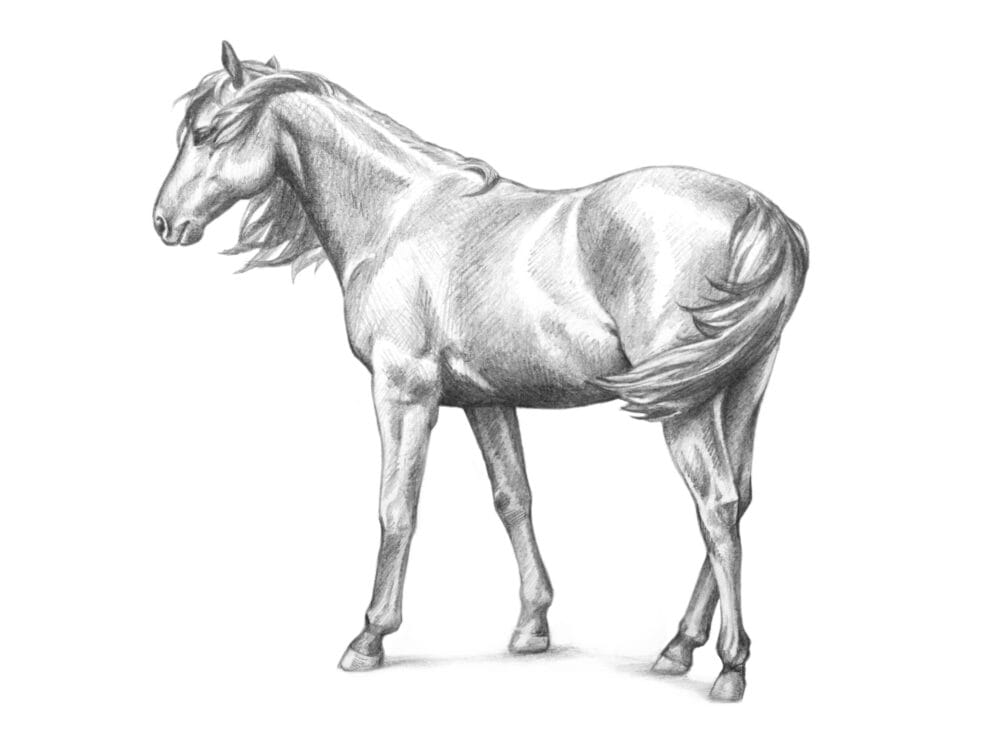Drawing a horse can be a fun and rewarding experience, whether you’re an aspiring artist or simply looking for a new creative outlet. Horses are elegant and majestic creatures, but capturing their essence on paper requires attention to detail and an understanding of their anatomy. Fear not. With a bit of practice and following a step-by-step guide, you can draw a horse confidently. Let’s trot through the process together!

Before You Draw a Horse: Gather Your Materials
Before you start, make sure you have the following items:
- Sketchbook or drawing paper
- Pencils a range of HB to B is recommended
- Eraser
- Pencil sharpener
- Reference photo of a horse optional
- Ruler for measuring and drawing straight lines
Now that your materials are ready, let’s move on to the first drawing steps.
So You Want to Draw a Horse? Start Here.
Before you put pencil to paper, take a moment to study the horse’s anatomy. It is critical to understand the proportions and placement of the head, torso, legs, and hooves. Understanding skull anatomy and eye positioning is also crucial for accurate representation.
Understanding Horse Anatomy
A full-body horse sketch starts by breaking down anatomy into recognizable parts. Notice how the muscles flow, where the joints are located, and how the mane and tail drape over the body. These key features will help you create a more realistic depiction.
A Step-by-Step Guide to Drawing a Horse
The first step starts with a simple sketch, starting with the basic shape of the body and head. In the second step, the facial features like eyes, nose, and mouth are detailed. In the third step, the contours of the body and legs are enhanced. In the fourth step, the mane and tail are brought into form. In the final, fifth step, the horse sketch is improved with light and shades to create a realistic horse drawing, all specified on a white sheet of paper.
Starting with Basic Shapes
Begin by sketching simple shapes to form the basic outline of the horse. Start with a large oval for the body and a smaller circle for the head. Connect these two with gently curved lines to represent the neck.
For the legs, draw four long, slightly tapered rectangles; the front legs are more vertical, while the hind legs have more of an angle to them. Sketch small circles for the joints and hooves. The basic shapes will guide you, ensuring correct proportions before adding details.
Refining the Outline
Once you have the basic shapes, refine the horse’s outline. Use your reference photo to help you shape the contours of the horse’s body, gradually replacing the geometric shapes with more organic lines.
Define the muscles and bone structure, being careful not to press too hard with your pencil; you may need to erase and adjust as you go. Add the curves for the belly, the chest, and the rump, keeping in mind the horse’s muscle tone and bone structure as you define the outline.
Adding Features and Details
With your basic outline complete, it’s time to add the features that bring your horse to life. Focus on the head: draw the eyes, ears, nostrils, and mouth carefully, as they are vital in expressing the horse’s character and mood. Remember to sketch the mane and tail, giving them a sense of movement and flow.
As you work on the details, consider the light source, which will dictate where the shadows and highlights should be. This will give your drawing more dimension and realism.
Finalizing Your Drawing
Refine your sketch by reinforcing the outlines and features with bolder strokes. Erase any remaining unnecessary guidelines. Work on the shading using your pencils to create different textures, such as the coat’s smoothness or the mane’s and tail’s roughness.
Finally, add shadows beneath the horse to ground your figure realistically. Pay special attention to the interplay of light and shadow on the horse’s body to create depth.
Now That You Can Draw A Horse…
Congratulations, you’ve completed your horse drawing! Remember, practice is key. The more you draw, the better you will become at capturing the beauty and grace of these stunning animals. Enjoy the process, learn from your mistakes, and experiment with different poses and styles.
Practice, practice, practice. Happy drawing!
A Multi-talented Spanish Painter
Joaquín Sorolla was a distinguished Spanish painter renowned for his masterful handling of light and color. Born in 1863 in Valencia, Spain, he grew up to become one of the most celebrated artists of his time. Sorolla’s style is often classified as Impressionist, but it also bears unique qualities that set his work apart.
Sorolla’s most acclaimed works are his beach scenes, which vividly capture the play of light on water, the movement of the sea, and the powerful musculature of large horses and oxen. Sorolla’s paintings are notable for their vibrant colors and the skillful depiction of sunlight and shadow, conveying a strong sense of warmth and vitality. His ability to capture the fleeting effects of light with rapid, confident brushstrokes was particularly remarkable.
A Master Draftsman: Joaquín Sorolla’s Horses
Apart from his beach scenes, Sorolla also painted portraits, landscapes, and historical and social themes. His paintings often depict his family and are admired for their intimacy and sensitivity. Sorolla’s works display a profound understanding of human character and emotion, making them compelling and relatable.
Sorolla was also a master draftsman who portrayed huge animals like horses, oxen, and bulls in motion. Once asked, What advice would you give students hoping to capture the essence, vitality, and strength of powerful animals like those in his paintings, he offered the following ten tips:
BONUS: Click here for Ten Ways to Improve Your Horse Drawings
- Observe in Detail: Spend time observing these animals in their natural environments. Notice how they move, rest, and interact with their surroundings. Observe the muscles, how light plays on their forms, and how their coats vary in texture and color. Realistic depiction begins with deep observation.
- Capture Movement: Powerful animals are defined by their movement. Sketch quickly to capture the essence of their motion. Don’t worry about details in these initial sketches; focus on the flow of their muscles, the weight of their bodies, and the energy of their movements.
- Study Anatomy: A strong understanding of animal anatomy is crucial. Study their skeletal and muscular structures. This knowledge will allow you to render them accurately, especially in dynamic poses.
- Play with Light and Shadow: Like in my beach scenes, light and shadow are crucial in defining form and creating a sense of vitality. Observe how light falls on the animal’s body, creating highlights and shadows that define their shape and movement.
- Use Dynamic Lines: In your drawings, use lines that vary in weight and intensity to convey the power and energy of these animals. Solid and confident strokes can impart a sense of strength and movement.
- Experiment with Perspectives: Don’t just stick to a single viewpoint. Try capturing these animals from different angles to find the most compelling way to showcase their power and majesty.
- Emphasize Key Features: Identify what makes each animal unique. It could be the curve of a horse’s neck, the bulk of an ox’s shoulders, or the intense gaze of a bull. Accentuating these features can capture the animal’s spirit.
- Convey Emotion: Beyond physical appearance, try to capture the animal’s temperament and spirit. Is the horse wild and spirited or calm and gentle? The emotional aspect can add depth to your drawings.
- Practice Consistently: Mastery comes with practice. Draw regularly and challenge yourself with different poses and settings. Each drawing will bring you closer to capturing the essence of these magnificent creatures.
- Stay Passionate and Curious: Finally, let your passion for art and your curiosity about the natural world drive your work. Art is a skill and a way of seeing and understanding life.
In 1909, Sorolla had a successful exhibition in the United States, significantly raising his international profile. He continued to paint prolifically until suffering a stroke in 1920, which severely limited his ability to work. He passed away in 1923.

Sorolla’s legacy is preserved in several museums, most notably the Museo Sorolla in Madrid, originally his home and studio. His works are celebrated for their luminous quality and joyful, life-affirming spirit.
As an art educator and enthusiast, exploring Sorolla’s techniques and approach to light and color can be immensely valuable, offering insights into capturing naturalistic effects in a vibrant, dynamic manner.
Remember, the goal is to replicate what you see and interpret it in your unique artistic voice. Each stroke of your pencil or brush should aim to convey the life and breath of these magnificent animals.

